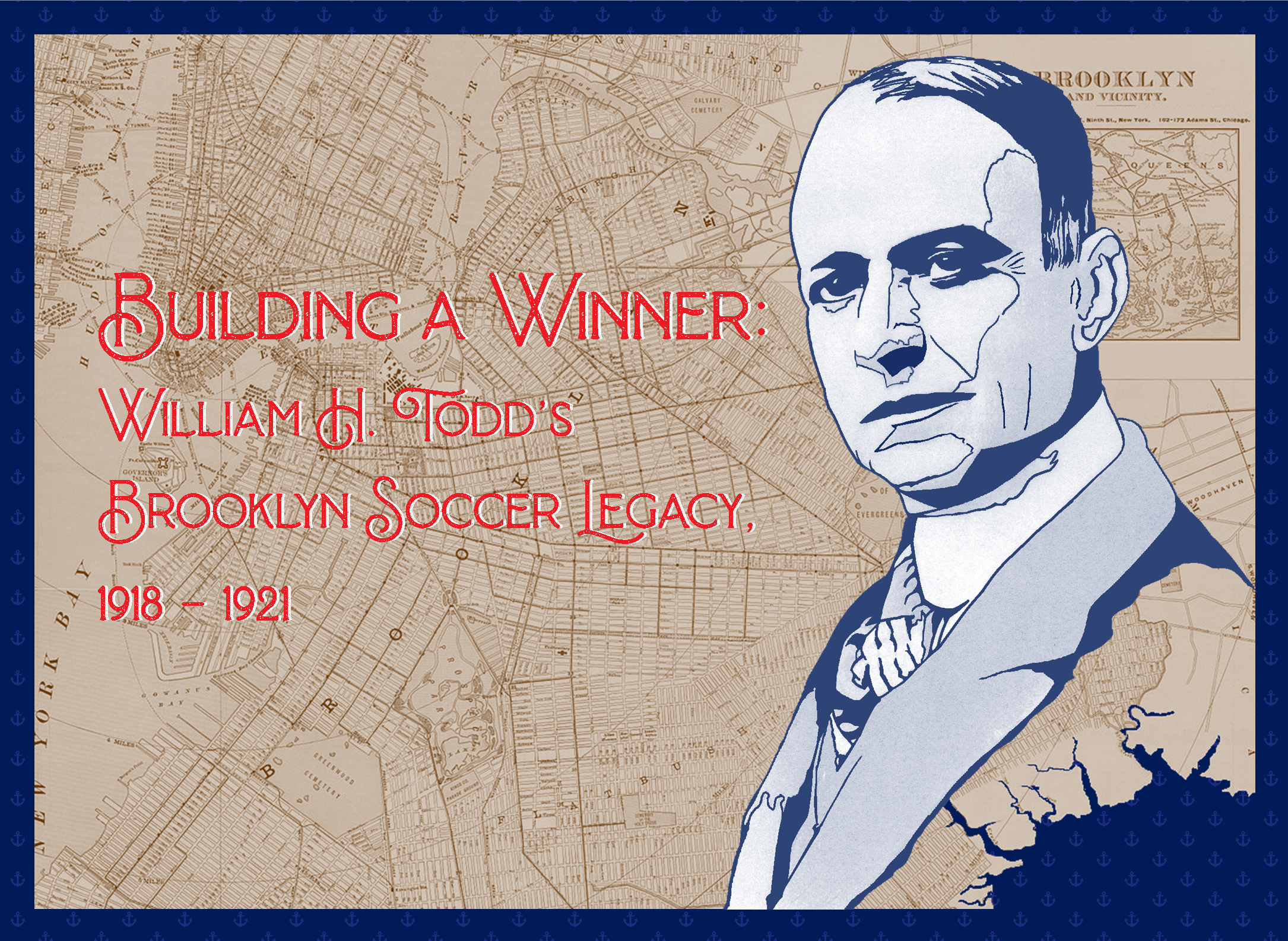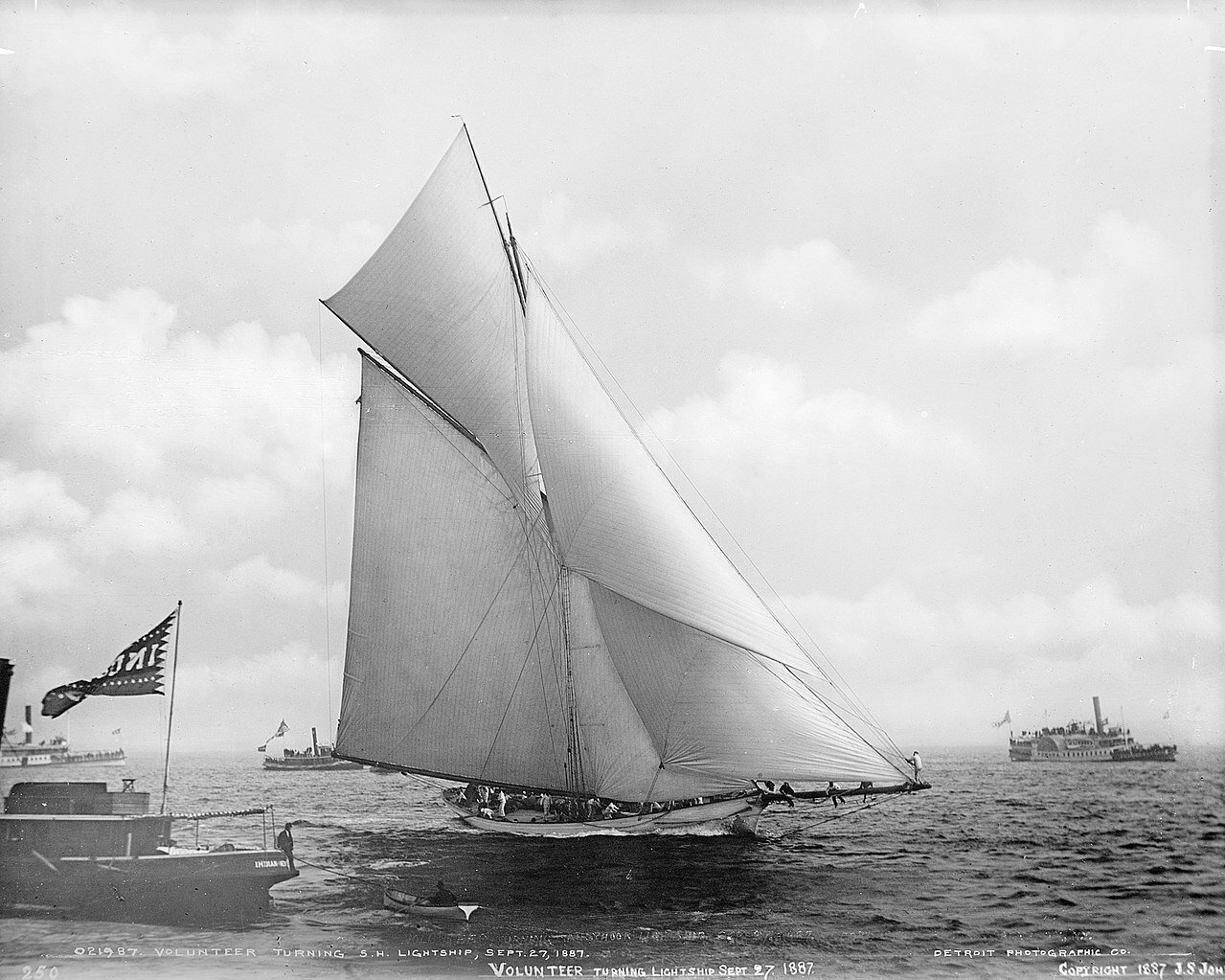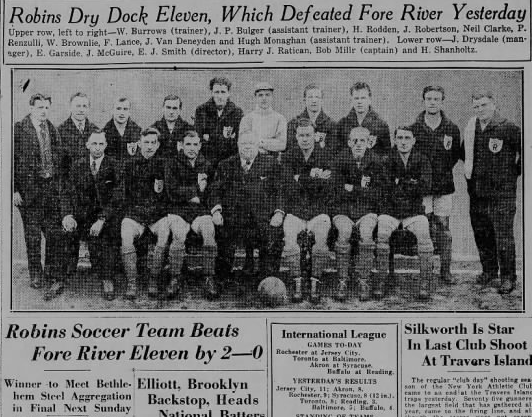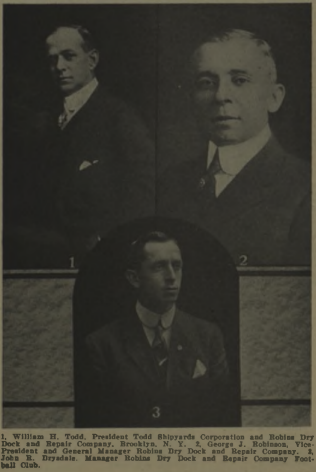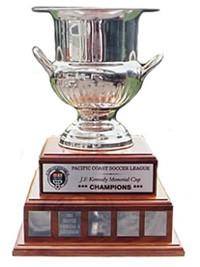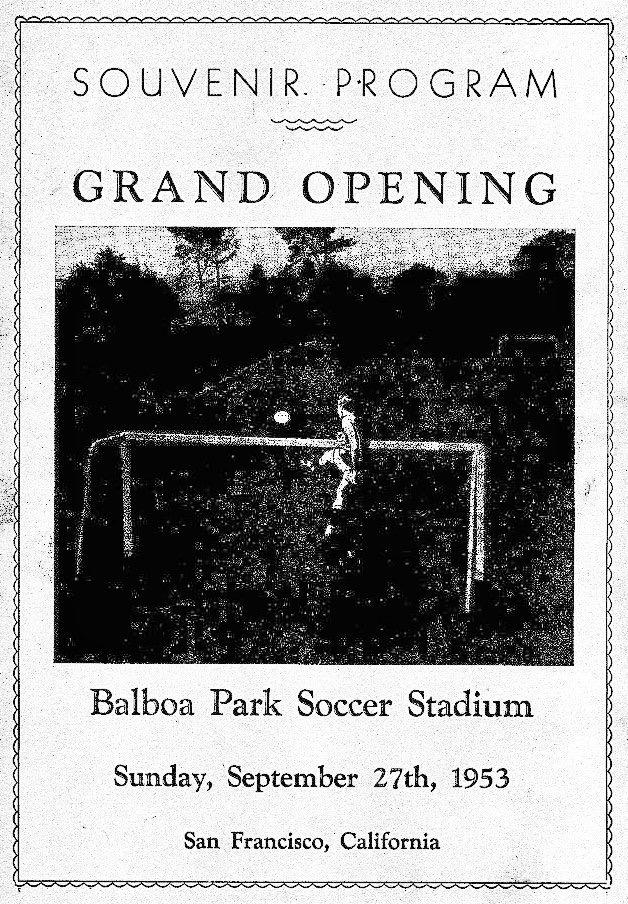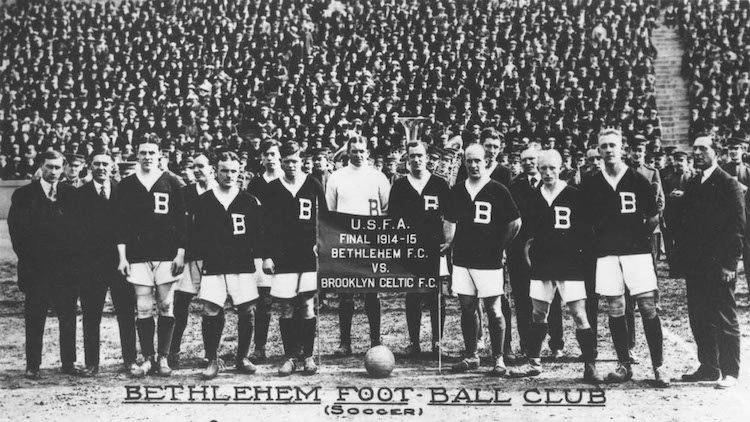Building a Winner: William H. Todd’s Brooklyn Soccer Legacy, 1918 – 1921
Be loyal to your men and they will be loyal to you - W.H. Todd
The Volunteer, a centerboard-compromise sloop, engineered by renown American ship designer Edward Burgess, defeated Thistle and won America’s Cup in 1887. The racing yacht was unfurnished below decks to reduce weight and was the first to be built with a steel frame and hull – her deck was made of white pine and she was an absolute pearl. Burgess had also designed the Mayflower, which won the America’s Cup just a year prior, however Volunteer was advanced in every way and skipper Hank Haff handily defeated the competition and took home the trophy. By the end of the 19th century, interest in yachting and ship building was at an all time high and due to the amazing progressions in technology, those wealthy enough to play in that arena could pour money into the sport and reap the rewards. Volunteer was retired from racing and sold for a considerable amount to John Malcolm Forbes, son of John Murray Forbes, the American railroad magnate who competed with the Vanderbilt family for money and influence.
Built in Wilmington, Delaware, Volunteer was a masterclass in both engineering and construction – she was assembled by the Pusey & Jones Corporation, which was founded in 1848 as a machine shop and rose rapidly to prominence after building sloops of war for the United States during the Civil War. Well-known for their top-quality work, Pusey & Jones was often subcontracted by competing shipbuilders to construct the engines and boilers for those vessels. One of the most well-regarded boilermakers at the corporation was James Todd, who brought his son to work with him as an apprentice. William Henry Todd, born in 1864, was 23 years old when he helped put Volunteer together for Pusey & Jones – his experiences working for a winning organization and understanding the value of hard work and craftsmanship would carry him through to high levels of success in everything he touched, both in shipbuilding as well as in sport.
William Todd first had a hand in “building a winner” with his hard work on the Volunteer while employed by Pusey & Jones.
In 1893, 29-year-old William Todd, left Wilmington in pursuit of more responsibility and challenge; he took a position at the Navy Yards in Brooklyn, New York. The United States was rapidly becoming one of the most influential economies in the world, exporting raw materials as well as manufactured goods to all corners of the globe. The US Navy was growing accordingly to ensure safe sea lanes were in place for the burgeoning American empire. Todd’s work was laid-out for him, and he was well-up for the challenge. Within three years, his authority and work ethic became infectious and again, he was ready for a new challenge – which he found in the Red Hook neighborhood of Brooklyn when he took a position as a foreman with Robins Dry Dock & Repairs Company.
“He began his work in private docks as a master mechanic; he was soon made assistant superintendent. His men looked up to him and his work was pushed ahead of others. He was learning to get things done and to get others to do them for him.” In 1909, when Robins’ founder, Mr. John R. Robins, was ready to step down and reinvigorate the company, there was nobody better suited to the task than the hard-working William H. Todd. Todd had some irons in the fire as well and shortly after the first World War broke out in 1914, his industry received an appreciated boost. “Old bottoms were hustled out of mud banks and sent into mudbanks where little expense was spared to make them seaworthy. Everything that could sport a sail or had a half-workable engine room left was being set to work.” Todd Shipyards was born and working double-time to get ships out to sea and defend the shipping lanes from the Germans. Robin’s Dry Dock was put under the new Corporation as a subsidiary, along with Tietjen & Lang from Hoboken, Seattle Construction & Drydock and Tebo Yacht Basin Company of Brooklyn, New York which were all purchased by Todd and merged into the new, massive ship building and repair company.
An early aerial illustration of Robins Dry Dock in Red Hook Brooklyn.
William Todd was a sporting enthusiast and a known philanthropist; he was a member of at least eight society clubs in New York, including the obvious ones like The Society of Naval Architects and Engineers and The Atlantic Yacht Club. However, he was also a paying member of the Crescent Athletic Club of Brooklyn and the New York Athletic Club. Though he was very likely aware of soccer as a competitive sport, as it was hard to miss at the time, Todd may have learned about the existence of Bronx United, Brooklyn Field Club, New York FC and their membership in the National Association Football League (NAFBL) from conversations with other patrons of his sporting society clubs. In addition to the NAFBL, there was the local metropolitan league and the La Sultana Cup, which pitted amateur teams from around the great state of New York against each other, as well. Todd understood how to build things; ships, businesses, and relationships with colleagues, as well as with his employees, and in 1918, as a means to keep morale high, Todd Field was built on the grounds at the Robins Dry Dock facility in the Red Hook neighborhood of Brooklyn.
Brooklyn was absorbed into New York City in 1898; within a decade immigration to New York from Europe had exploded and peaked in 1907, with 1.3 million people coming through Ellis Island alone. Hundreds of thousands of newcomers, who brought their old world culture, would make the boroughs of the City, including Brooklyn, their new home. They brought something else as well, an absolute love for soccer. However, the parks all around New York, which bore the name of the cultures carving out space for themselves, were not necessarily “brimming with soccer fields.” Soccer was being played, however, and there are mentions of “football” being played at the Parade Grounds in Prospect Park and at Dyker Park, but NYC Parks was unable to determine, a hundred years after the fact, which type of football might have been played.
Todd Shipyards added Todd Field to their primary grounds where Robins Dry Dock was located and teams from Robins, Tebo Yacht Basin, and Tietjen & Lang Drydock all played their home games.
A Brooklyn Annual Report from 1916 tells us “the popularity of soccer football in the park playgrounds is increasing each year” and public parks would organize local inter-park soccer tournaments. But this was far from the higher level of soccer being played in the NAFBL and La Sultana Cup, “As with several recreational pastimes, including golf and swimming, this is one area where the Parks Department wasn’t always the only game in town. Soccer, perhaps more than other sports, was dependent on private associations. Naturally then, the New York men (and women too!) interested in soccer formed clubs that were privately run and often sponsored by the companies for which they worked. They also often played on fields furnished by the company.” William Todd was evidently not satisfied in simply encouraging his employees to play in local park tournaments, by assigning valuable property in a very compressed New York landscape to build out a soccer field, he was getting ready to add a team to the ranks to either the NAFBL, the New York State Football League… or both.
Tebo Yacht Basin, one of Todd Shipyards’ recent acquisitions, was well known for its work in assembling top-quality American yachts, and was just two miles away from Todd Field. Located at the end of 23rd, near the Bush Terminal, the neighborhood just east was incorporated into Sunset Park in the 1960s and is now considered a part of Greenwood Heights; however, at the time, it was all just considered South Brooklyn. Todd would authorize Tebo Yacht Basin to form a squad and join the Metropolitan league in New York in 1918; Tebo Yacht Basin FC started their season being drawn to play and lost to Viking FC in round one of the National Challenge Cup. A loss they would exact revenge for a few years later in the La Sultana Cup.
The 1918-19 National Challenge Cup (now the US Open Cup) also shows another Todd Shipyards subsidiary soccer team in the tournament, Tietjen & Lang, of Hoboken, New Jersey. They were battered in the first round 0-6 by The Scottish-Americans of Kearny, New Jersey. There’s no further mention of this club, however, and it might be assumed they began the same year as Tebo Yacht Basin, and their successful sister club, Brooklyn Robins Dry Dock FC. All three clubs likely played at Todd Field and it would be Tebo Yacht Basin FC and Robins Dry Dock FC who would begin the organization’s amazing haul of cups and league titles from all over the region in such a short span of time.
In an era bereft of transfer periods or window, Robins Dry Dock FC accumulated some of the era’s most talented players as their season progressed.
Robins’ first season began in the Autumn of 1918 as well, with entry into the National Challenge Cup - they won their way through the first round, into the second and defeated Bridgeport City FC of Connecticut to make it to the third round. Unfortunately they lost to eventual Cup Runners-Up, Patterson FC, but it took Paterson a replay to get the win. Robins’ roster was surprisingly well-loaded; the Great War had just ended in November of that year and it had taken its toll on the rosters, not just of soccer teams in New York, but of all sports anywhere. Young men from all over the nation were drawn into service for their country and that left many sports organizations scrambling, not only to fill their rosters, but to even compete. The NAFBL was forced to allow three teams to bow out before the season even began and a fourth club, the East Newark Scots-Americans, left the competition - drained of players after five games. Robins Dry Dock FC were allowed to join the league during week six, and assume the schedule of the Scots-Americans who vacated their fixture list.
Robins finished fourth that season, followed it up by finishing third in 1919-20 and third again in 1920-21; while third place is a respectable finish for most clubs, it was the cup competitions where Robins Dry Dock FC really made their hay. In their three years of existence, they got laid up in the semifinals of the American Cup once and won the whole competition twice - beating Fore River and Bethlehem Steel respectively. Bethlehem Steel had won five of the previous six American Cup finals before getting knocked down a peg by Robins Dry Dock FC. Robins made it a double over Bethlehem Steel in 1919-20, by knocking them out of the National Challenge Cup (this even came on the heels of knocking Fall River out the round prior - Robins were a force to be reckoned with after only a couple years on the scene).
It was that 1919-20 National Challenge Cup semi-final which set something more in motion for Robins, while after all the noise they made beating storied clubs like Bethlehem and Fall River, they went out with a whimper to Fore River. William Henry Todd, owner of Todd Shipyards Corporation and sponsor of his subsidiary organizations’ soccer teams, did not like to lose. He had a track record of reorganizing and finding the best of the best to make things happen. Todd spent the 1920-21 season acquiring assets; he brought in an entire pantheon of soccer talent from the roaring twenties: Bob Millar was brought over from Bethlehem Steel, along with Thore Sundberg, George McKelvey and Harry Ratican.
Bethlehem Steel took a tour of Scandinavia, where they found Thore Sundberg, whom Todd in turn tempted over to his Robins Dry Dock project.
Hall of Famer Robert “Bob” Millar had two stints with Bethlehem Steel before signing with Robins Dry Dock in 1920, but this wasn’t his first time playing for a Brooklyn club - he had originally come over from St. Mirren in Scotland and became a bit of a journeyman, playing for 14 different American clubs (including a loan spell at Tebo Yacht Basin too). Sundberg, of course, was signed away from AIK Solna by Bethlehem Steel on a tour of Europe in 1919 - he was highly regarded as a “leading forward in Sweden” with a pair of caps for his country but extensive experience leading the line for AIK from 1916 until he was swept to the US to play in the American Cup. At some point Todd, or Robins coach JR Drysdale, liked what he saw and stole him away from Bethlehem.
George McKelvey had played for Bethlehem during one of their most impressive periods - winning their respective league five times, accumulating four National Challenge Cups and five American Cups with the legendary team. However, at some point in the 1920-21 season, McKelvey moved from Pennsylvania to Brooklyn to run the rule on the right side of the field for Robins. The most impressive jewel from this heist, however, was the addition of US National Team player and future US Hall of Famer, Harry Ratican. He won back-to-back NAFBL titles with Bethlehem and scored critical goals in both their National Cup wins over Fall River and Paterson, respectively. But Todd wasn’t done loading up his roster, he and coach Drysdale plundered Fall River for Fred Beardsworth and Neil Clark, then Scottish players Robert Hosie from Llydebank and Jack McGuire from St. Johnstone - this move for Scottish players would later become endemic of wealthy American clubs paying over the odds for talent, however, in 1920-21 the soccer wars were still in the offing and Todd had a dream team to assemble. Already there was another future Hall of Famer, goal-keeper Peter Renzulli, a New York Native, who made his debut for Robins Dry Dock FC in November 1919, but had established himself as a bit of a local legend playing in those local parks tournaments, then for the likes of St. Georges and Manhattan in the New York State League.
Without a transfer period, clubs could poach players at any time of the season. National Soccer Hall-of-Famer Frankie Vaughn, touted as never having played for anyone other than Ben Millers, actually transferred to Robins for the 1920-21 NAFBL season.
Unbeknownst to all eight clubs in the league at the time, the 1920-21 NAFBL season would be the last one on record - Brooklyn Robins finished 3rd on points (12) behind New York FC (17) and league winners Bethlehem Steel (23). It wasn’t the prize they were seeking, however, after going out in the semifinal of the 1919-20 National Challenge Cup to Fore River, Robins were seeking retribution. Especially so after seeing that Fore River lost in the final to Ben Millers 1-2. In the 1920-21 tournament, the Robins eleven would find their way past their opponents, round after round. On November 25th, it was a convincing win over Columbia Graphophone 3-0; they snuck past Erie AA in the 4th round after a replay. Robins ran into Fore River in the quarterfinals but exacted their revenge with a 3-0 thumping. Interestingly enough, they ran into their sister club Tebo Yacht Basin in the semifinals, but proved why they were the top club and won 3-0 again. On April 19th, 1921, Brooklyn Robins Dry Dock FC made it to the final of the National Challenge Cup to play the two-time winner of their own St. Louis Soccer League, Scullin Steel FC.
The USFA National Challenge Cup Final annually rotated to a new neutral site; in Pawtucket, Rhode Island in 1918, Fall River, Massachusetts in 1919, St. Louis, Missouri in 1920 and Robins would take on the Scullin Steel eleven in the “City of Hills and Mills,” in the southwestern part of Massachusetts. The Final had returned to Fall River and according to the match report from the 1921 Spalding’s Guide to Soccer, “It mattered not to the fans of this section that the Fall River Rovers were not battling on the field that day. Fall River Fans rallied to the support of the game.” With an attendance listed at 8,000 it's easy to assume at least a few hundred made it up from St. Louis or New York for the final, but that level of interest from the neutral fans shows an immense level of interest in professional soccer at the time.
“Robins twice before had been a strong bidder for the highest honors soccer has to bestow in this country, but on both occasions had missed out when the achievement of their greatest ambition seemed imminent,” reports Spalding’s. It was even well-known at the time that Robins had been close contenders and those losses galvanized their sponsors, Todd Shipyards, to spend the money in order to win the prize. The money was well spent too, “Robins exercised the famous short passing style of play that is common to the team comprising kickers from across the water.” Scullin’s dependence on American grit and determination, the kick and run style of play, was no match for the fancy footwork and quick passing of Robins’ forward line.
The score-sheet from the match report shows the game might have been slightly more interesting to begin with however, Scullin scored first with a goal from Charles Bechtold in the 15th and Robins’ Jack McGuire answered immediately in the 16th to make it even. Scullin Steel went ahead again just minutes later when Bechtold scored his brace. Unfortunately for Scullin, it was at that point that Robins took control of the match and three more players contributed to the win; Robert Hosie in the 29th, Peter Sweeney in the 64th, and George McKelvey finished off the evening with a fourth goal for Robins Dry Dock in the 71st. “Much credit must be given the speedy forward line of the brilliant Robins eleven. Their pace was remarkable. Sweeney, Hosie, McGuire, Ratican, and McKelvey - perhaps no swifter combination has been known to the soccer world of the present day.”
Todd, center, and his National Champion Robins Drydock eleven.
At only their third foray into the National Challenge Cup, Robins Dry Dock had wielded the buying power of their parent organization, Todd Shipyards, and brought the title home to Brooklyn. “The Robins Dry Dock and Repair Company Football Club of Brooklyn equalized in 1920-21 the earlier record of the Bethlehem Steel Company eleven by winning both the National Challenge Cup and the annual trophy of the AFA, next in importance, perhaps, to the national championship.” Robins had done the double. The same squad who knocked Fore River out of the National Challenge Cup in the quarterfinal then humbled them again with a thumping 5-2 defeat in the American Cup final. Harry Ratican, Hosie, Sweeney, Sturch, and McGuire all tallied in the match and Robins were arguably the best American soccer team in 1920-21.
Meanwhile, outside of soccer, the world was still recovering from both World War I as well as the Spanish Flu Pandemic. Complications from these two global issues triggered a sharp deflationary recession in 1920 which lasted until early summer of 1921. The United States was seeing an influx of Veterans which overwhelmed the civilian workforce while the demand for iron, steel, fuel, and especially wartime shipbuilding was in a downturn. It's difficult not to suspect this would have had an economic impact on Todd Shipyards Corporation - in addition to the three soccer teams they were sponsoring in three different leagues in and around New York, Todd’s first Pacific acquisition, the Seattle Construction and Drydock company, may also have been fielding a soccer team in Washington state. William H Todd, even in an economic recession, was immensely wealthy, but he was also a businessman and read the writing on the wall. The NAFBL’s collapse and subsequent rise of the first iteration of the American Soccer League, gave him the perfect opportunity to make his move.
Coming on the heels of Robins Drydock FC’s successes and Tebo Yacht Basin FC’s respective success (having won the La Sultana Cup of New York by defeating Viking FC 2-0) William Todd decided to merge the three, assuming Titjen & Lang’s team was still operating to some extent, and form Todd Shipyards Football Club. This must have come as a shock to the players of both of the corporation’s successful squads as both had planned on joining the newly formed American Soccer League (ASL) and now only one team would be financed by the parent company. Robins’ coach JR Drysdale would stay on as the Todd Shipyards coach and would take most of his national championship winning roster with him. By May of 1921, just a month after the National Challenge Cup Final, the ASL was planning its season and was including the newly formed Todd Shipyards FC in that plan - Todds was spending money on upgrading Todd Field for their first fully professional season and looking to add a few more players to their all-star roster.
By the Spring of 1921, the NAFBL was collapsing as the teams at the top were looking for something higher profile and the teams at the bottom couldn’t afford to keep going as they were. Todd completed the merger of Tebo Yacht Basin FC, Robins Dry Dock FC, and for what it's worth, probably Tietjen & Lang. Manager Drysdale was able to recruit William Whitehead, Adam Smith, James Campbell, and Bill Fryer into the new team and headed into their initial American Soccer League (ASL) season as favorites to make some noise. The ASL was a combination of the old NAFBL with teams from the Southern New England Soccer League and hopes were high. However, the league hit a few snags in the beginning, and despite throwing $6,000 ($79, 476.49 in today’s money) at their newly minted franchise, Jersey City Celtics folded. According to David Wangerin in Soccer in a Football World, “The remaining seven clubs lasted the season, but winter postponements and apathy toward meaningless end-of-season matches - particularly when visiting teams had little financial incentive to travel - meant some did not fulfill all their fixtures.”
The increased costs of competing in the expanded area of the ASL and the issue of dealing with incompetent fellow ownership groups became a burden on teams like Todds who, by all accounts were still well-funded. However, with the economic stresses of 1921-22 combined with the haphazard way the new league was run, Todd Shipyards would not return for another season. Which was a shame too, because despite all the ailments of the league, Todds, led by the “Mac Attack” of Frank McKenna, Jack McGuire, and George McKelvey were putting on lively displays of attacking prowess. After 24 games played in the league, Todd Shipyards finished 3rd behind Philadelphia FC and New York FC, but boasted a +19 goal difference and a return trip to the National Challenge Cup final - against none other than Scullin Steel FC.
Scullin Steel FC didn’t switch leagues; they weren’t bogged down with upgrading their facilities or spending funds on long-distance away days. By and large, Scullin Steel remained the same club that they were the year before and they leveled all competition on their way to the Cup Final in 1922; 2-0 over Johnston City, 3-0 over Ben Millers, 3-0 again beating Pullman FC, and thumping Caledonia FC 4-0 in the semifinal. Scullin hadn’t given up a goal in the entire competition. Todds’ path was a little rockier; 5-3 over NY Field Club, 4-1 over Philadelphia Field Club, cutting it close with a 1-0 victory against Harrison SC, and just getting past Abbot Worsted in their semifinal, 2-1. Todd Shipyards was clearly dealing with a bit of pressure to return to the final and juggle that with the inconsistencies of league play in the ASL.
On March 19, 1922 Scullin Steel FC met Todd Shipyards FC for a rematch of the previous year’s National Challenge Cup Final. Scullin had every reason to feel that they had this one in the bag and had done everything possible to get to High School Field in St. Louis, Missouri - in front of 9,000 spectators and in their very own backyard. According to the match report, “until fifteen minutes before game time the rain came down in torrents.” The pitch was a muddy disaster and for the first half an hour, the home team were anchored as Todd Shipyards came in with their tails up. Jack McGuire, with an assist from Ratican, scored the first goal of the contest in the 17th and just two minutes later, he doubled their scoreline. Scullin Steel were shocked it would take them until nearly the end of the half to get back in the match but once they did, they never looked back, “The youth and stamina of the Scullins started telling. And once the Eastern veterans started to tire, the Scullins were by far the better team. The forwards played as they should, while the halfbacks broke up the combination play of the drydock eleven.”
After William Todd’s passing, the corporation sold off some assets while adding others, but his name remained on the letterhead until the 21st century.
Scullins unabashedly went very direct, and according to the 1922 Spaldings Guide to soccer, “The Scullins forwards gave an exhibition of the worth of the long pass. All three goals were made possible by the use of the strictly American style of play. Ability to beat the heavier and slower moving Todds to the ball also helped materially.” Cliff Brady pulled one goal back before the half, with an assist from Charles Bechtold. Once play resumed in the second half, Todds were done for - while they had 16 shots on goal in the first half, they only mustered 3 shots in the second half; they also managed to out-foul Scullins, a true sign they had lost their steam in the rain and muck. Elmer “Allie” Schwarz tied the game up in the 71st and the two sides went hammer and tongs for another quarter of an hour. “To Elmer Schwarz, center forward of the Scullins, went the honor of bringing the title back to St. Louis. It was Schwarz who in the waning moments of the second half booted the mud-soaked ball into the upper corner of the net for what proved the deciding point.”
And so it was, Scullins Steel had given everything they had to get back to the final and were happy to face a shadow of a team they had played just a year before. Todd Shipyards FC was devastated - the organization would never field a team in any east coast league again, professional or amateur. It had simply proved to be bad business for William H Todd and he found he could get the same level of competitive satisfaction from playing the stock market in the 1920s - until that also proved to be poor business, as the stock market crash of 1929 would prove. At the age of 68, in 1932, William H Todd passed away and by 1937 Tebo Yacht Basin had been sold to Sullivan Drydock. Todd Shipyards sold some assets and bought others while becoming one of the world’s most successful shipbuilders in the 20th Century. Vigor Industrial bought Todd Shipyards outright in 2011 and ended the story of the vision and effort of William H Todd.
Sources used for this article:
https://www.nycgovparks.org/parks/todd-triangle/history
https://img2.newspapers.com/clip/23324394/wh-todd-profile-shipyard-1917/
https://www.newspapers.com/clip/40784245/022622-boston-globe-abbot-worsted/http://worldwidesoccerstories.blogspot.com/2013/12/playing-in-states-early-edition-part-two.html
https://www.ussoccer.com/stories/2020/04/global-pandemic-world-war-and-the-1919-open-cup
https://thecup.us/2011/09/30/the-open-cup-final-1914-present/
https://timesmachine.nytimes.com/timesmachine/1921/04/18/98672456.pdf
https://en.wikipedia.org/wiki/Tebo_Yacht_Basin_F.C.
https://en.wikipedia.org/wiki/Brooklyn_Robins_Dry_Dock
